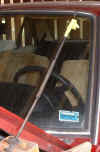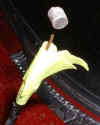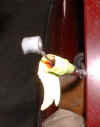|
|
|
Oiling control cables shouldnít be a big deal but sometimes it turns out to be a little tougher than it looks on the surface.
Open wire wound cables like this one
are easy to lube, just about any kind of oil will do with thin oil
working better than thick. Just run a light line of oil down the
outside of the housing, it will penetrate between the wires and oil
the cable quite nicely. It may require a couple of wipe-downs
with a rag or one saturated with solvent to keep the outside clean but
the oil will get on the outside anyway no mater how you work this
type.
|
| Cables with a solid sheath must be disconnected on one end, and itís best to secure that end higher than the other so the oil can run all the way through. |
| If it werenít for the fitting swaged on this cable you could slip a piece of tubing tightly over the sheath to act as a funnel or reservoir. We used masking tape instead. Any tape you use gets gooey from the oil, and masking tape works best because it comes off easiest. A wrap three thicknesses deep is about right; and if you can make it come to a funnel shape at the top thatís all the better. |
|
Make the reservoir area about 3/4"
deep. One filling per two feet of cable is about right to lube a
complete cable. When using a piece of tubing it doesnít matter
how far past the sheath it extends but the same rule of thumb for
volume still applies. Automatic transmission fluid or any
thinner oil will do just fine. Marvel Mystery Oil was used in
this demonstration. MM oil seems to have a lot of paraffin in it
and that will stay put and lubricate even after the oil itself dried
up. One oiling like this should be all that a sheathed cable
needs in a lifetime no matter what kind of oil you use.
|
|
|



